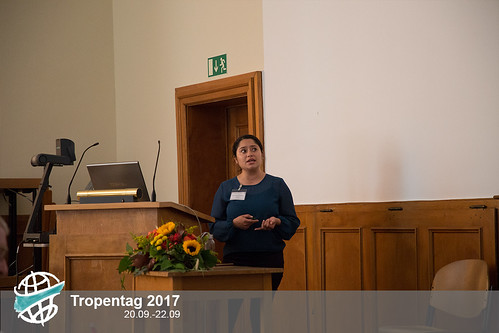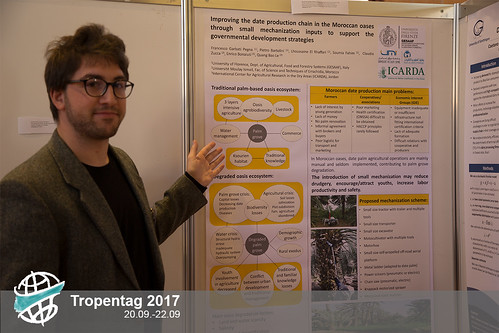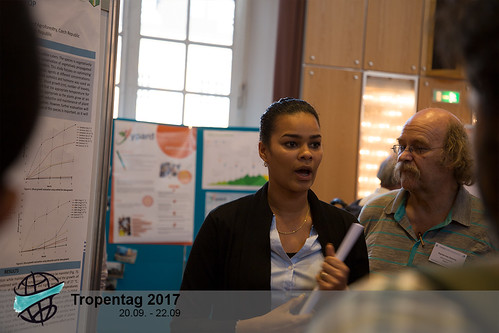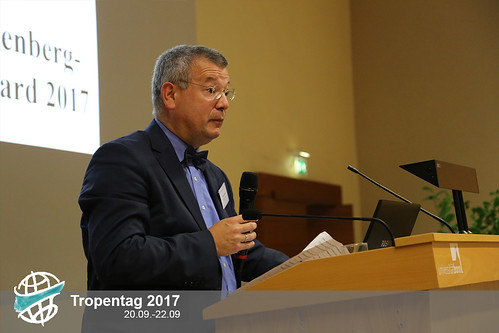giulia.rotanodari's blog
A Changing Environment Changing Lives
Sun, 09/24/2017 - 13:06 — giulia.rotanodariIn many countries, migration is a growing phenomenon because of political, economic and environmental reasons. In the last few decades, sudden or long-term changes in the environment are further exacerbating the often already precarious conditions in Sub-Saharan Africa, shaping the livelihoods of subsistence farmers in particular. This is shown by a study conducted in Ethiopia by Juliane Groth, from the Helmholtz Centre for Environmental Research (UFZ) during the "Institutions and Livelihood" oral presentation session .
By analyzing the reasons that force rural people to migrate, Groth found that this phenomenon is strongly linked to land degradation and shifts in rainfall seasonality. These are the drivers of the decline in livestock quantity and agricultural production. As a result, farmers are looking for fast growing crop varieties that allow for cultivation in a shortened rainy season.
Groth's study is evidence of the need for global intervention with programs to mitigate the impacts of climate change, especially by working with farmers to develop and introduce faster growing crops.
The Ice is Melting! Perceptions of Climate Change in Peru
Thu, 09/21/2017 - 18:01 — giulia.rotanodari71% of tropical glaciers in South America are found in Peru and the ongoing increase in the average global temperature is causing their retreat in many areas, threatening livelihoods.
Yaremi Karina Cruz Rivera, from Cologne University of Applied Sciences, analyzed the perceptions of climate change of four communities living in the surrounding area of the Chicon glacier, one of the highest tropical glaciers in Peru, and the source of water for the Chicon Watershed. The four communities make use of the water in this area for human consumption and agriculture.

The aim of the investigation was to assess the awareness of the communities, in particular of women, of the hazards linked to climate change. Results showed that people perceive that temperatures are increased and extreme climactic events such as droughts, floods and frosts have occurred frequently in the last decade, but drought is the most imminent challenge.
The four communities demonstrated an awareness of the threat of climactic change to agriculture and their livelihoods, leading to an interest in implementing activities and ecological approaches, such as afforestation in the watershed together with the local government.
We Need Youth! Small mechanization to preserve Moroccan Oases
Thu, 09/21/2017 - 13:03 — giulia.rotanodariFor centuries, oases supported agriculture and sustained livelihoods in arid climates. Over the last few decades, oases in Morocco have been progressively neglected. They are fragile ecosystems and without constant care from the next generation, are facing progressive degradation. Date palms are one of the most important resources in an oasis, but as a consequence of the progressive land abandonment, the loss of knowledge and labour force are hindering its production.
The University of Florence, in collaboration with the University of Moulay Ismail and ICARDA, proposed the introduction of small machines as a possible solution to reduce the drudgery of farm work, facilitate field operations, and make agriculture more attractive for the young farmers.

However, Pietro Bartolini explained that the main limitations may be linked to access, in fact the investment cost is often not affordable for smallholders. For this reason, the proposed intervention will target local cooperatives, in order to ensure a better economic sustainability.
Tubers that don't want to grow up!
Thu, 09/21/2017 - 09:55 — giulia.rotanodari Stacy Hammond from the Czech University of Life Sciences conducted a brilliant investigation on how to effectively slow down the growth rate of Ulluco (Ullucus tuberculosus)(Loz.) of the Basellaceae family, an important Andean staple crop, so it can be efficiently conserved for farmers and for future generations. I certainly hope that these findings will serve as a basis for future studies in genetic resources and conservation.
Stacy Hammond from the Czech University of Life Sciences conducted a brilliant investigation on how to effectively slow down the growth rate of Ulluco (Ullucus tuberculosus)(Loz.) of the Basellaceae family, an important Andean staple crop, so it can be efficiently conserved for farmers and for future generations. I certainly hope that these findings will serve as a basis for future studies in genetic resources and conservation.
ICRAF presents: Trees as a means of land restoration
Wed, 09/20/2017 - 22:51 — giulia.rotanodariSoil, soil everywhere, but not a spot to plant.
Land degradation is an important global environmental issue in the 21st century and is having a huge impact on agricultural productivity, food security and livelihoods. Moreover, as Tony Simmons, director general of the World Agroforestry Centre (ICRAF) stated, economic losses from it account for a loss of $10.6 trillions a year.
Young Scientists Win Award for Fight Against Hunger
Wed, 09/20/2017 - 19:53 — giulia.rotanodari “Genome based identification of heterotic pattern in rice”, Ulrike Beukert, University of Martin-Luther-University of Halle-Wittenberg
“Genome based identification of heterotic pattern in rice”, Ulrike Beukert, University of Martin-Luther-University of Halle-Wittenberg
Rice is one of the most important staple crops in the world. A lot of research has been conducted, but more investigations are needed in order to optimize land use by maximizing yield. Ulrike Beukert, a MSc. student at the University of Martin-Luther-University of Halle-Wittenberg, conducted an investigation on boosting yield by exploiting heterosis in rice. Results show that heterosis provides enhanced yield stability and increased abiotic and biotic stress resistance.




